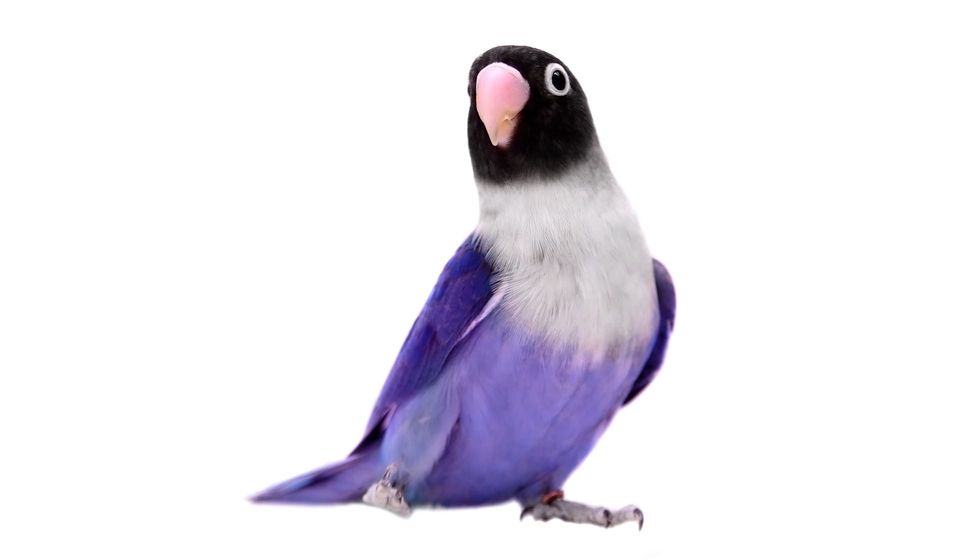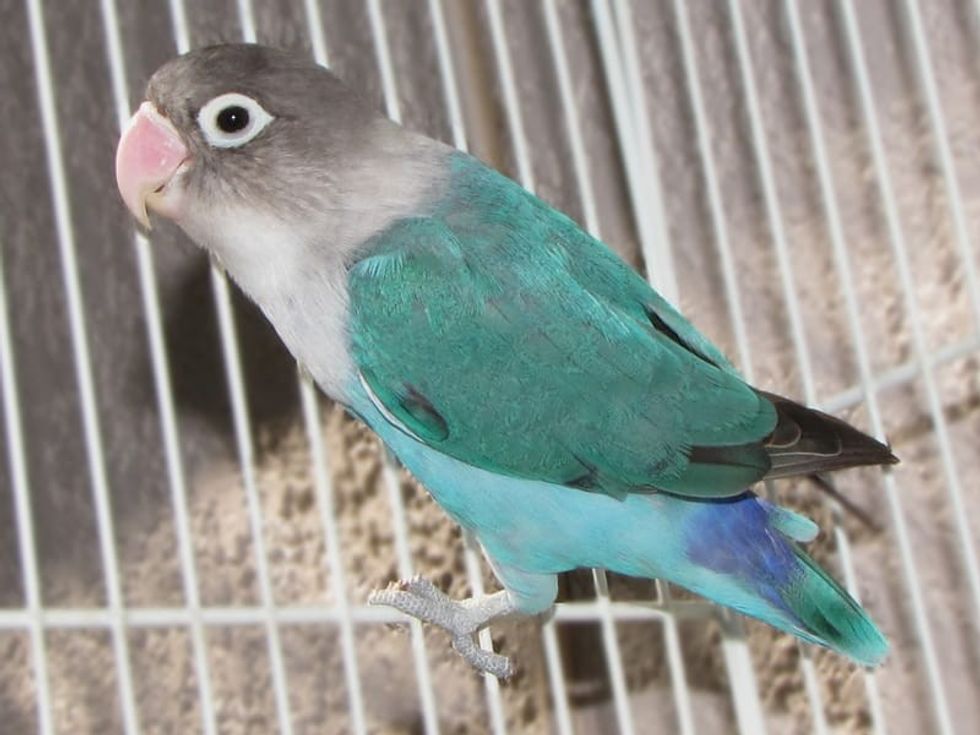We are going to learn about the Agapornis personata in this article! They are a particular species of Aves (birds) grown in captivity over several years. This has led to their mutation into four colors.
These Aves prefer to live in pairs and love to play and climb. It is important to note that they have certain specific tendencies and get unhappy if these conditions are not met. Read on to find more about these birds!
If you like this article, then perhaps you will like our other articles as well on animals like the black-winged lovebird and violet-backed starling.
Violet Masked Lovebird Interesting Facts
What type of animal is a violet masked lovebird?
The violet-faced lovebird (Agapornis personata) belongs to the family of Psittacidae. Their genus is Agapornis. They have a high-pitched voice and prefer to live with a companion. Although their sound call is not as high as that of a parrot, it still can get quite noisy at some parts of the day.
What class of animal does a violet masked lovebird belong to?
The lovebird (Agapornis personata) belongs to the class of Aves.
How many violet masked lovebirds are there in the world?
The population of this species of lovebirds is abundant in the environment. They are known for breeding by people to keep as pets because of which they are also referred to as pet birds. There are several colors of lovebirds in the world due to color mutations.
Where does a violet masked lovebird live?
This species of bird lives in brushwoods, trees, and near coastal areas. These birds are mostly found in Tanzania and northeast Kenya. They are natives of Africa.
What is a violet masked lovebird's habitat?
A faced lovebird of this color lives in brushwoods, trees, and near coastal areas. However, lovebirds have come to be known as pet birds and so the breeding of this bird is done in captivity as well.
Just keep in mind to provide them a similar environment and another bird companion if you ever decide to keep them as pets.
Who do violet masked lovebirds live with?
These birds are famously known to live in pairs. They need their companion lovebird to be able to live a healthy life. They are social birds and practically need a companion to live happily. It has been observed that they get aggressive in aviary settings.
How long does a violet masked lovebird live?
The lifespan of a masked lovebird is 18-20 years provided they are well-cared by their owners.
How do they reproduce?
This bird has been referred to as 'eye-rings' by breeders. There are various species of these birds that can be bred in captivity.
Their breeding is done easily in colonies. The blue masked lovebird is an excellent bird for a breeder who has just begun breeding birds.
These birds breed either in colonies or in single pairs. The behavior that these birds exhibit is similar to masked lovebirds. If you are breeding them in captivity, it is important to provide them with a nest box with twigs, strips of bark, and other nesting material.
The female birds lay three to four eggs at once which have to incubate for about 25 days. When the young birds become independent they are moved to their own separate housing.
There are several mutations of the masked lovebirds which include the blue masked lovebird, black-masked lovebird, yellow collared lovebird, and the violet masked lovebird. These mutations happened through their breeding over several years in captivity.
What is their conservation status?
The conservation status of masked lovebirds is acknowledged by the IUCN as animals of Least Concern. The masked lovebirds are found in the wild which is their natural habitat and in cages where they are bred in captivity or kept as pets.
Violet Masked Lovebird Fun Facts
What do violet masked lovebirds look like?
The masked lovebird of this color is the best-known color mutation of this species. They are found in abundance in the wild as well as in captivity. This bird has an extremely attractive blue/violet head and body.
The masked lovebird has a white collar around its neck and on its upper breast. All the mutations of masked lovebirds have a black mask. There are several mutations of this bird that have been created in captivity.
These include the blue masked lovebird, black-masked lovebird, yellow collar lovebird, and the violet masked lovebird. The color of their body determines their namesake. Most of the masked lovebirds have a red beak.

*We've been unable to source an image of a violet masked lovebird and have used an image of a masked lovebird instead. If you are able to provide us with a royalty-free image of a violet masked lovebird, we would be happy to credit you. Please contact us at hello@kidadl.com*
How cute are they?
.Masked lovebirds are extremely cute and beautiful. They are famously known as love birds so it is no secret how much people adore these birds.
Be it the black mask lovebird or the blue masked lovebird or the bird which is peach-faced with a red beak or the yellow masked bird, they are all cute and beautiful. All of them are kept as a pair in a cage by breeders and people who keep them as pets.
How do they communicate?
The masked lovebird communicates through sounds and body postures. Although its voice is not as loud as the parrot, it is still considerably loud.
They prefer to move either in flocks or in pairs because they are social birds. It is important for them to live a healthy life. This blue masked or black-masked or peach-faced lovebird usually has a calm demeanor but can tend to get aggressive in aviary settings.
In this situation, their voice gets extremely loud and they produce a teetering sound. Their aggressive behavior is rare.
How big is a violet masked lovebird?
The masked lovebirds are small birds that can fit in the palm of your hand. The masked lovebirds mentioned in this article are 6 in (14.5- 15.5 cm) in size which makes them two times smaller than a housecat.
How fast can a violet masked lovebird fly?
The masked lovebirds of all colors love to fly, climb and play. As we already know they love to socialize and have very playful behavior.
Masked lovebirds including the black-masked lovebirds, blue masked lovebirds, yellow masked lovebirds have a moderate flight speed. They fly impressively but sadly we do not have information regarding their wingspan or the accurate speed of their flight.
How much does a violet masked lovebird weigh?
The weight of a masked lovebird is not known. However, we do know that they are birds that like to play and are active. They are also very small in size so it is highly likely that they are light.
What are the male and female names of the species?
The male and female masked lovebirds do not have a distinct name. Like any other bird, the male bird is called a cock, and the female bird is called a hen.
This applies to all colors of masked lovebirds including the black-masked lovebirds, blue masked lovebirds, and the birds with a yellow and violet face. They have a bright head and light body. They are very active.
What would you call a baby violet masked lovebird?
The young bird of this species is referred to as a fledgling. They are kept under the care of the males and female birds for about 25 days. The young birds also have a similar beak and mask as their parents.
The diet of a young bird includes fruits, vegetables, and seeds. These feeding habits develop in young birds from the beginning only after they hatch from eggs.
They find their own food upon growing up. They do not stay in the nest of their parents once they are independent enough. They move to a different nest.
What do they eat?
The diet of these lovebirds includes vegetables, seeds, and fruits. They start feeding on these once they hatch from their eggs. It takes about four weeks for their egg to hatch. These weeks are also referred to as the incubation period.
Are they dangerous?
These birds are not dangerous at all. Their feeding habit and tendency to live with a pair of their own breed makes them very calm, friendly, and sociable.
Would they make a good pet?
They are everyone's favorite choice for a pet. They have a bright color on their mask and feathers, are light as paper, and have a very easily accessible diet. They look very pretty and love to play around.
If you are deciding to keep them as pets, know that it is important to let them out of their cage once in a while so that they can fly. It is important that they do so to maintain their chirpy behavior.
They can get unusually loud at times but not as loud as parrots. This is a major complain by pet owners but know that it is not as bothersome. There are ways to calm them down.
Did you know...
They have been bred in captivity for several years now. Due to this, they have mutated into several different colors.
Initially, through mutations, only blue lovebirds with green shades on their feathers existed. Later over the years birds with light colors such as white were born. Lovebirds are not migratory by nature but will migrate if the water supply runs low.
It is popularly believed that the black mask ave needs grit however this is a common misconception. They do not need to consume it. If they are healthy the consumption of grit will not harm them but this might happen if they consume it while they are sick.
What is the most expensive lovebird?
The most expensive and rare lovebird to be found in the world is the white lovebird. They are very costly and difficult to grow.
Are masked lovebirds easy to breed?
These birds are probably the easiest to breed. It is important to keep them in pairs and make them a nest with willow twigs, tree branches, and other nesting essentials. The maintenance cost of these birds is not very high. The young birds have to be taken care of closely but they grow up soon enough.
Here at Kidadl, we have carefully created lots of interesting family-friendly animal facts for everyone to discover! Learn more about some other birds from our flycatcher fun facts and Malabar gray hornbill interesting facts for kids pages.
You can even occupy yourself at home by coloring in one of our free printable exotic bird coloring pages.










